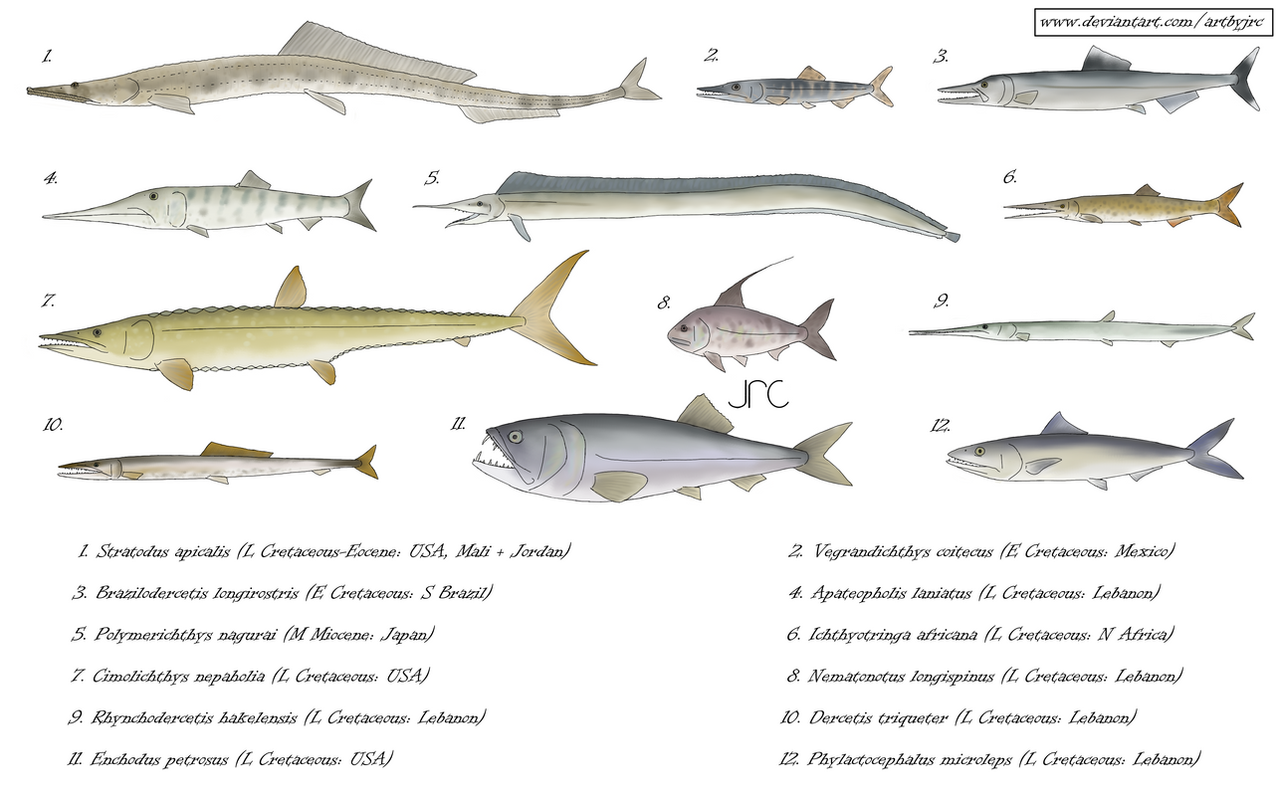HOME | DD
 artbyjrc — A sharp toothed grin - Aulopiforms
artbyjrc — A sharp toothed grin - Aulopiforms

#cretaceous #enchodus #extinct #fish #miocene #paleocene #eocene #teleost #apateopholis #brazilodercetis #dercetis #cimolichthys #stratodus #aulopiform #ichthyotringa #rhychodercetis #nematonotus #polymerichythys #phylactocephalus #vegrandichthys
Published: 2023-06-06 08:31:05 +0000 UTC; Views: 21455; Favourites: 255; Downloads: 55
Redirect to original
Description
A selection of extinct members of the teleost fish known as aulopiforms. Not to scale.
With over 50% of all living vertebrates being actinopterygians or ray-finned fish, one can expect some oddballs, both from the past and present (see Mystery moons + secret serpents - Lampriforms , Biting beaks - Tetraodontiforms ). The aulopiforms are no exception. All are found in marine environments (including deep-sea, benthic and pelagic), have generally long slender bodies, and share a common structure of the gill arches. Generally not famliar to the general public, living species are known as lizardfish, grinners, lancetfish (Longnose Lancetfish skull ), tripodfish and daggertooths. They are distributed across four of the five suborders with several close fossil relatives being known. The oldest known aulopiform fossil, Nematonotus, from the earliest stages of the Late Cretaceous shares an elongated dorsal fin with other aulopids (flagfins). An unusual species from the Miocene was the long-snouted alepisauroid Polymerichthys which combined features in common with the related daggertooths (skull anatomy) and lancetfish (elongate body with a dorsal fin running the full length). However the vast majority of fossil aulopiforms are from the diverse enchodontoid suborder.
Many enchodontoid families share the long slender body and elongate skull of a lurking predator (see Lurking arrows - Ambush predatory fish ) - dercetids (Dercetis, Brazilodercetis, Rhychodercetis), cimolichthyids (Cimolichthys), ichthyotringids (Ichthyotringa), and apateopholids (Apateopholis). They probably hid amongst aquatic vegetation and used a short burst of speed to catch unsuspecting prey.
Most familar of the fossil aulopiforms were the so-called sabre-toothed 'herrings', Enchodus. Nearly 30 species are known from Late Cretaceous deposits around the world. Characteristically they had long fangs in the front of both jaws which were ideal for gripping slippery prey, however it required a rapid open and closing of the mouth to swallow prey. Large eyes indicate good eyesight and it it is thought that Enchodus ambushed prey from below. It was one fish to survive the K-Pg mass extinction event. Another impressive fish to survive the Cretaceous extinction event was the anguilliform Stratodus. Up to 5 m long and closely resembling a sea-serpent, it was covered in armoured scales and had numerous (6000!) needle-like teeth in around the lips of the mouth.
Related content
Comments: 15

👍: 2 ⏩: 0

👍: 1 ⏩: 1

👍: 1 ⏩: 0

👍: 1 ⏩: 0

👍: 1 ⏩: 1

👍: 0 ⏩: 1

👍: 1 ⏩: 1

👍: 0 ⏩: 1

👍: 1 ⏩: 0

👍: 2 ⏩: 1

👍: 1 ⏩: 0

👍: 1 ⏩: 1

























